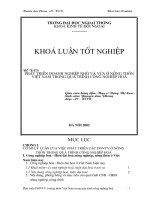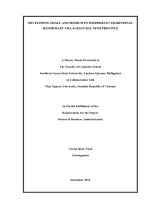phát triển doanh nghiệp vừa và nhỏ trong các làng nghề truyền thống của tỉnh bắc ninh
Bạn đang xem bản rút gọn của tài liệu. Xem và tải ngay bản đầy đủ của tài liệu tại đây (1.71 MB, 179 trang )
DEVELOPING SMALL AND MEDIUM ENTERPRISES IN TRADITIONAL
HANDICRAFT VILLAGES IN BAC NINH PROVINCE
A Doctor Thesis Presented to
The Faculty of Graduate School
Southern Luzon State University, Lucban, Quezon, Philippines
in Collaboration with
Thai Nguyen University, Socialist Republic of Vietnam
In Partial Fulfillment of the
Requirement for the Degree
Doctor of Business Administration
Vuong Quoc Tuan
(Strongman)
December 2014
TABLE OF CONTENTS
CHAPTER 1: INTRODUCTION 1
1.1. Background of the study 1
1.2. Objectives of the study 4
1.3. Hypotheses 5
1.4. Scope and Delimitation 5
1.5. Significances of the study 6
1.6. Definition of terms 7
CHAPTER 2: REVIEW OF RELATED LITERATURES AND STUDIES 9
2.1. Related Literatures 9
2.1.1. Concepts 9
2.1.2. An Overview of Small and Medium Enterprises 13
2.1.3. Small and Medium Enterprise Development and Business Development in
Traditional handicraft villages in Bac Ninh Province 31
2.1.4. Factors Affecting the Development of Small and Medium Enterprises 46
2.2. Related Empirical Studies 50
2.3. Conceptual Framework 56
CHAPTER 3: RESEARCH METHODOLOGY 57
3.1. Research Design 57
3.2. Population, Sample Size and Sampling Technique 57
3.3. Description of Respondents 58
3.4. Research Instrument 58
3.5. Data Gathering Procedures 59
3.6. Statistical Treatment of Data 59
CHAPTER 4: FINDINGS AND SOLUTIONS ABOUT CURRENT SITUATION ON
DEVELOPMENT OF SMALL AND MEDIUM ENTERPRISES IN TRADITIONAL
HANDICRAFT VILLAGES OF BAC NINH PROVINCE 61
4.1. Overview of traditional handicraft villages and small and medium enterprises in
traditional handicraft villages in Bac Ninh province 61
4.1.1. Traditional handicraft villages 61
4.1.2. Small and medium enterprises in traditional handicraft villages in Bac Ninh
province 63
4.1.3. Employment and income in small and medium-sized businesses in handicraft
villages, traditional handicraft villages in Bac Ninh province 65
4.2. Features of the elements in external environment affect the development of small
and medium enterprises in handicraft villages, traditional handicraft villages in Bac Ninh
province 66
4.2.1. Group of policy factors 66
4.2.2. Group of administrative procedure factors 71
4.2.3. Group of geography, infrastructure factors 80
4.2.4. Group of financial and economic factors 85
4.2.5. Group of labor factors 88
4.3. Assessing the internal problems of small and medium enterprises in handicraft
villages, traditional handicraft villages in Bac Ninh province today 94
4.3.1. Group of business owner factors 94
4.3.2. Group of labor factors 99
4.3.3. Group of organizational structure factors 102
4.3.4. Group of raw material factors 106
4.3.5. Group of technological level factors 110
4.3.6. Group of financial capacity factors 115
4.3.7. Group of product and market factors 119
4.3.8. Group of production and business result factors 126
4.4. Analysis of factors affecting the development of small and medium enterprises in
traditional handicraft villages in Bac Ninh province 130
4.4.1. Factors affecting the growth in the number of small and medium-sized
enterprises 131
4.4.2. Factors affecting the gross revenus of small and medium-sized enterprises in
traditional handicraft villages of Bac Ninh province 133
4.5. Assessing the strengths, weaknesses, opportunities and challenges for the
development of small and medium enterprises in traditional handicraft villages in Bac
Ninh province 134
4.6. Limitations and challenges of the SME sector 136
4.7. Orientation and solutions for SMEs development in traditional handicraft villages of
Bac Ninh province in the near future 138
4.7.1. Orientation 139
4.7.2. Development Goals 139
4.7.3. Solutions for the development of SMEs in traditional handicraft villages in Bac
Ninh province 140
CHAPTER 5 148
CONCLUSION AND RECOMMENDATION 150
5.1. Summary 150
5.2. Conclusions 151
5.3. Recommendations 153
BIBLIOGRAPHY 155
APPENDICES 161
1
CHAPTER I
INTRODUCTION
Due to the important role of small and medium-sized enterprises,
many countries have focused on encouraging this type of enterprise
development. Institutional support nature to encourage include: Support to create
a favorable business environment (development and promulgation of the law on small and
medium enterprises, to facilitate licensing, supply information , etc.), the business support
capacity building (training resources management, technology support , etc.), and the
support of credit (bank established professional for small and medium enterprise loans,
credit guarantees for enterprises, the establishment of venture capital companies , etc.), and
other support (such as business premises).
According to the Vietnam Association of Small and Medium Enterprises
(VINASME), up to 96% of registered enterprises in Vietnam are SMEs. This unit
generated 40% of gross domestic product, generating more than 1 million new jobs each
year, mainly beneficial especially for untrained labor. For many years, the volume of
SMEs is still the engine that runs the economy of Vietnam. But have to admit the fact, this
volume is also thrive in areas with modest margin, low technology so there is no advantage
in size (financial resources, area of operation, market share, etc.) that often focus on issues
such as selection of business objectives consistent with the ability, stability and
consolidation of market share or develop gradually and selectively market stage, the
sudden most favorable break. SMEs still have the motor and the link to business
cooperation that lack of clarity of the role of state policy.
1.1. Background of the study
Small Business Development Plan and medium period 2011 - 2015 has been
approved by the Prime Minister, in which the goal of bringing the number of newly
established small and medium-sized enterprises in 2011-2015 is expected to 350,000
enterprises. Target set by the time on 31.12.2015, there were 600,000 active enterprises.
(
vua/20129/148542.vgp).
Small and medium-sized enterprises play an important role in socio-economic
development and active support for the development of big business, but they have certain
restrictions on capital, production technology, production ground So, requiring solutions,
long-term policies to support enterprises to overcome difficulties and improve
competitiveness towards the goal of sustainable development.
2
According to a survey of the Department of Business Development (Ministry of
Planning and Investment), officially recognized in 2001, by the end of June / 2012, the
country has 658,645 SMEs registered establishment, of which 468,023 enterprises activity
(about 71.1%). The number of SMEs in terms of the labor force each year by an average of
22.11% / year (if in 2000 more than 38,000 companies, 2010 was over 283,000).
In 2010, Bac Ninh Province have been granted business registration certificates for
797 enterprises, including: 748 enterprises granted business registration certificates of the
Company Law, 100% new business was established in 2010 small and medium-sized
enterprises; 49 FDI investment certificates associated with the establishment of enterprises,
branches, representative offices under the Investment Law; as the end of 2010, Bac Ninh
province has a total of 4.293 enterprises, in including 5 state enterprises and private
business 4013, 275 FDI enterprises.
In general, businesses in the province to develop good business in accordance with
law, to be effective, has potential exploit local strengths such as capital, labor, skill, level
workers, especially is in the local traditional handicraft villages. Private sector was
contributing to production development, create jobs, increase budget revenues, improve
people's lives; contribute to poverty reduction, economic restructuring towards
industrialization of modernization and contribute significantly to the socio-economic
development of the province. Enterprises have increasingly conscious mouse than in the
observance of safety, occupational health and insurance.
Results of implementation plan for SME development in the province of Bac Ninh
2006-2010. Bac Ninh Province to encourage and create favorable conditions and support
people to establish enterprises; province has planned and established industrial parks, small
and medium-sized industrial clusters, industrial villages, to help people set up businesses
have leased premises conditions for investment in the business.
The province has implemented mechanisms, effective new policies to improve the
business environment. PCI index increasingly improved rankings year after more than year
ago: rated 22 (2006), No. 16 (2008); 2009, provincial competitiveness index of the North
increased security 6 Level No. 10 compared to nationally and internationally as one of
three leading provinces PCI index of the northern provinces; 2010, the provincial
competitiveness index of Bac Ninh increased to 4 Level stand 6 compared with nationally
and internationally as one of the top leading PCI of the northern provinces.
On the business side: The majority of SMEs have small capital, so the investment
in modern technology and equipment (mostly imported from abroad) is very difficult,
3
while to the competitive foreign companies to continuously improve equipment, reduce
input costs. State policies to support credit loans but access to capital is impeded by the
small value mortgage, can not afford credit guarantee; SMEs often lack and difficulties
with most kinds of business are not given priority in terms of production, often using their
own homes, and hiring of private land lease prices high, there is still discrimination.
Low level of technology and quality of labor is limited, derived from small-scale
features which should virtually restricted business investment in modern technology and
equipment.
Management level and low-skilled, the number of SMEs through training
percentage is very low and virtually untrained professional; while workers mostly manual
labor, only trained short-term job or the labor shift from agriculture to up the skill is still
limited. Therefore, the application of modern advanced technology is also difficult.
SMEs lack information and remain flat side of the relationship (the state, the
market, banking, science centers and training centers, etc.). Internet access and applications
in business for SMEs constrained by insufficient qualifications as well as the cost is quite
high compared to the size of the small business.
SME Development Goals 2011-2015: accelerate business growth and enhance the
competitiveness of SMEs, business investment environment and convenient, equitable,
transparent to the SME contribution increasing economic development and improve
national competitiveness.
Target SME Development 2011-2015: number of newly established enterprises
increased by 25% / year; each year about 500 new established enterprises and 20,000
employees supported technical training, and technical management in SMEs; meet the
basic business of the production business.
The story of a representative enterprise producing bamboo handicrafts in Y Yen
District, Nam Dinh said: Although the village is famous for its line of bamboo lacquer
products, but the products must through intermediate systems, inaccessible to direct
customers. There is time for the people of this village to busy racing competition, including
not healthy, so it's time for poor quality products. When the product is on the market,
customers see poor quality so next time do not buy anymore.
Notably, there are many large business companies do not get the goods of this
village that takes the product of another village, while other villages choose to buy
products that actually get the product from this village for sale rather than production. This
4
situation led SMEs in this village that the deadlock, even feel the "injustice" in the
marketplace. However, according to Pham Chi Lan, this is something quite common in
villages in Vietnam.
Being aware of mentioned issues and with the support from small and medium
enterprises in traditional handicraft villages in Bac Ninh province and consultant from
supervisor, with the purpose of enhancing quality and quantity of not only products of
SMEs but also SMEs themselves, the researcher studied this thesis entitled “Developing
small and medium enterprises in traditional handicraft villages in Bac Ninh province”.
1.2. Objectives of the study
The general objective of the study is to know about the current situation of small
and medium enterprises development and then to propose feasible solutions for the
development of traditional handicraft villages in Bac Ninh province. The specific
objectives of the study are as follows:
1. To determine the profile of small and medium enterprises in traditional
handicraft villages in Bac Ninh province in terms of:
- Capitalization/investment;
- Type of products;
- Number of employees;
- Scope of operation.
2. To analyze elements in external environment and internal environment that
affects the development of small and medium enterprises in traditional handicraft villages
in Bac Ninh province in terms of:
* External environment:
- Policy;
- Economics and Finance;
- Administrative procedure;
- Geography, infrastructure;
- Labor.
* Internal environment:
- Human resource (Business owner; Labor);
- Organizational structure;
- Production (Raw material; Product and market).
- Technological level;
- Financial capacity;
- Production and business result.
5
3. To assess the strengths, weaknesses, opportunities and challenges for the
development of small and medium enterprises in traditional handicraft villages in Bac Ninh
province based on SWOT analysis.
4. To determine the significant difference between problems identified by both
groups of small and medium enterprises inside and outside traditional handicraft villages in
Bac Ninh province.
5. To propose feasible solutions for 5-year development plan of small and medium
enterprises in traditional handicraft villages in Bac Ninh province.
1.3. Hypotheses
There is no significant difference among the perception of the respondents about
conditions for the development of small and medium enterprises in traditional handicraft
villages in Bac Ninh province in terms of:
* External environment:
- Policy;
- Administrative procedure;
- Geography, infrastructure;
- Economics and Finance;
- Labor.
* Internal environment:
- Business owner;
- Labor;
- Organizational structure;
- Raw material;
- Technological level;
- Financial capacity;
- Product and market;
- Production and business result.
1.4. Scope and Delimitation
The main goal of this study is to find out solutions for the development of small
and medium enterprises in traditional handicraft villages in Bac Ninh province The
researcher completes this study with belief that its result will help SMEs in traditional
handicraft villages can develop stronger.
6
Due to the author’s limitation of time, the research only studied some contents
related to factors of external environment (Policy; Administrative procedure; Geography,
infrastructure; Economics and Finance; Labor) and factors of internal environment
(Business owner; Labor; Organizational structure; Raw material; Technological level;
Financial capacity; Product and market; Production and business result) that affect the
development of SMEs in traditional handicraft villages in Bac Ninh province.
Describing methodology and with survey questionnaires as a main tool to collect
the data and information will be utilized in this study.
1.5. Significances of the study
This study will be beneficial to the following:
For managers of research units:
The study shows out the limitations as well as find out conditions needed for the
development of small and medium enterprises in traditional handicraft villages in Bac Ninh
province, so it helps managers of research units to identify solutions and build strategies to
remove the difficulties and support SMEs in the province in some different ways and
improve investment environment to attract resources from outside of province such as
investment capital, science technology, scientific management, also exploit and promote
the province's comparative advantage in productions and business, trade and services,
infrastructure and available labor resources of the province to enhance the development for
SMEs in traditional handicraft villages.
For research unit:
By realizing appropriate conditions for the development and from which by offered
proper solutions, the study helps research units receive better policies to perform well their
businesses and develop more strongly.
For the researcher:
This study helps to complete the PhD thesis, besides it also enhances studying
ability, accumulate knowledge for the author.
For future researchers:
This study will serve as a reference for future studies and researchers on research
methods, analysis and evaluation of conditions for the development of small and medium
enterprises in traditional handicraft villages, from which researchers’ future studies will
determine the issues for related further studies.
7
1.6. Definition of terms
Capitalization: is the sum of a corporation's long-term debt, stock and retained
earnings.
Small and Medium Enterprise: is an independence manufacture base, business
registered pursuant to current law, has registered capital not higher than VND 10 billion or
the yearly average labors numbers are not over 300 people.
Traditional handicraft villages: are villages appear long ago in history and still
exist today, as the village has existed for hundreds of years, even thousands of years, is
closely related to factors traditional and popular experience has been accumulated over
many generations back.
Policy: Refers to the set of basic principles and associated guidelines, formulated
and enforced by the governing body of an organization, to direct and limit its actions in
pursuit of long-term goals to create favorable conditions for enterprises.
Administrative procedure: A fixed, step-by-step sequence of activities or course
of action (with definite start and end points) that must be followed in the same order to
correctly perform a task.
Infrastructure: Refers to basic physical and organizational structures needed for
the operation of enterprises (in this study, they are SMEs in traditional handicraft villages
in Bac Ninh province), and facilities necessary for them to function.
Economics and Finance: Focused on the elements of money, risk, opportunity
cost and other variables related to financial decisions. This field of study concentrates on
how financial moves are made under uncertain conditions.
Labor: The aggregate of all human physical and mental effort used in creation of
goods and services. Labor is a primary factor of production.
Business owner: Individual or entity who owns a business entity in an attempt to
profit from the successful operations of the company. Generally has decision making
abilities and first right to profit.
Organizational structure: The typically hierarchical arrangement of lines of
authority, communications, rights and duties of an organization. Organizational structure
determines how the roles, power and responsibilities are assigned, controlled, and
coordinated, and how information flows between the different levels of management.
8
Raw material: Basic substance in its natural, modified, or semi-processed state,
used as an input to a production process for subsequent modification or transformation into
a finished good.
Technology level: The purposeful application of information in the design,
production, and utilization of goods and services, and in the organization of human
activities.
Financial capacity: Refers to ability of enterprises in terms of money, capital and
equity.
Product: Is anything that can be offered to a market that might satisfy a want or
need. In the study, products are types of subjects made by traditional handicraft villages in
Bac Ninh province.
Market: A medium that allows buyers and sellers of a specific good or service to
interact in order to facilitate an exchange.
Production and business result: Refers to output in the process of manufacture
and business operation of the enterprises.
9
CHAPTER 2
REVIEW OF RELATED LITERATURES AND STUDIES
This chapter will present concepts and theories that have significant effect on the
conduct of the study. Review of related literatures and study will present what had been
written about the subject. Finally a Conceptual framework that will aid the conduct of this
research work will be established.
2.1. Related Literatures
2.1.1. Concepts
2.1.1.1. Development
Development refers to the systematic use of scientific and technical knowledge to
meet specific objectives or requirements. Development in its simplest definition and
perhaps in its common usage can be considered as the objective of moving to a state
relatively better than what previously existed: “good change” as defined by Chambers
(2007). As change is a process, this definition of development tends to denote a process
towards a desirable state in society.
Whether this state is achieved in the short or long term, change has several
implications for society. Disruption may occur in the established patterns of living within
the society as it moves towards good change, and thus reflect a contradiction to its intended
meaning, and generate a discourse on what constitutes this “good change” (Thomas, 2000).
As a result, the term development in both academic and non-academic fields has enjoyed
an ambiguous position of being alluded to a diversity of meanings defining or evaluating
what “good change” is, and who this good change belongs to.
In general terms, “development” means an “event constituting a new stage in a
changing situation”. If not qualified, “development” is implicitly intended as something
positive or desirable. When referring to a society or to a socioeconomic system,
“development” usually means improvement, either in the general situation of the system,
or in some of its constituent elements. Development may occur due to some deliberate
action carried out by single agents or by some authority preordered to achieve
improvement, to favorable circumstances in both. Development policies and private
investment, in all their forms, are examples of such actions.
Given this broad definition, “development” is a multi-dimensional concept in its
nature, because any improvement of complex systems, as indeed actual socio-economic
systems are, can occur in different parts or ways, at different speeds and driven by different
forces. Additionally, the development of one part of the system may be detrimental to the
development of other parts, giving rise to conflicting objectives (trade-offs) and conflicts.
10
Consequently, measuring development, i.e. determining whether and to what extent a
system is developing, is an intrinsically multidimensional exercise.
2.1.1.2. Small and Medium Enterprises
Small and medium enterprises are the enterprises with small scale in terms of
capital, labor or revenue. Small and medium enterprises can be divided into three
categories based on size includes micro enterprises, small enterprises and medium
enterprises.
Statistical definition of SMEs varies by country and is usually based on the number
of employees, and value of sales and/or value of assets. According to the criteria of the
World Bank Group, micro enterprises are enterprises with the number of workers fewer
than 10 people, small businesses are the number of employees from 10 to 50 people, while
medium enterprises have from 50 to 300 labors.
To date, a single, universally accepted definition of the term small and medium
sized enterprise (SME) still remains elusive among countries and blocs across the world.
Each country defines SME based on its economy’s characteristics and states of
technological development in order to devise programs to support these targeted firms.
Since there are “significant differences in aggregate income and its distribution, in
production structures and capabilities, and in industrial and technological characteristics
among economies” (Asasen and Asasen, 2003), it is not unexpected that the definition of
SME will vary greatly from one country to another. Some countries distinguish between
small and medium-sized firms, while others put them all into one category. Some use the
capital investment criterion, while others do not. That is also the case with assets and
annual sales criteria.
Furthermore, the level of labor and capital intensity required by firms differs
noticeably among countries and across different sectors within a country. This is because
different countries give preference to different areas. A country with a focus on labor-
intensive industries such as the textile industry will not put as high a capital investment
benchmark to categorize a firm as an SME as does a country with a focus on capital-
intensive industries such as the automobile industry.
Because this research limits its scope to Vietnamese SMEs only, the official
definition by the Vietnamese government (Government Decree 90/2001/ND-CP dated
November 23, 2001) was adopted. The definition is stated as follows:
“SMEs are independent production and business establishments which make
business registration according to the current law provisions, each with registered capital
not exceeding VND 10 billion (equivalent to US$ 621,774.547) or annual labor not
11
exceeding 300 people. On the basis of the concrete socio-economic situation of each
branch or locality, in the course of implementing the support measures and programs, both
or either of the above-mentioned criteria on capital and labor may be applied in a flexible
manner.”
Moreover, according to Decree No. 56/2009/ND-CP dated 30 June 2009, SMEs
comprise the businesses registered in accordance with the Enterprise Law, cooperatives
and individual business households, of either micro, small, or medium size. There are two
criteria for defining the type of SME, namely scale of total assets (as the prior criterion),
and annual average number of employees. In particular, a micro-sized enterprise is defined
as one having 10 or fewer employees.
Table 2.1. Classification of SMEs
Source: Decree No. 56/2009/ND-CP.
Up to May, 2010, over 55% are micro-sized enterprises with the number of permanent
laborers being fewer than 10.
Table 2.2. Classification of SMEs by Scale of Labor Dimension
Source: White book on SMEs in Vietnam 2009.
Note: Unit in %
12
According to the White Book on SMEs in 2009, from 2000, the average registered
capital of enterprises increased by 9 times over the 2000 - 2008 period. The increases were
0.962 billion, 3.14 billion, 8.1 billion and 8.7 billion VND in 2000, 2006, 2007 and 2008
respectively.
2.1.1.3. Traditional handicraft villages
The village is a cluster of residents in a village (the village) has one or several lines
are removed from production agriculture to independent business, is the village
nonagricultural sectors dominate the household, number of employees, and the income
from farming.
Traditional handicraft villages are villages appear long ago in history and still exist
today, as the village has existed for hundreds of years, even thousands of years, is closely
related to factors traditional and popular experience has been accumulated over many
generations back. There are many traditional handicraft villages in Vietnam such as the
paper Phong Khe commune, Dong Ho folk paintings, Luy Lau pottery, wood carvings at
Dong Giao, Dong Ky.
In the past, after harvest time, Vietnamese people made handicraft works to meet
their own needs. Their products are very skillful and sophisticated, even though they are
farmers and do not specialize in handicrafts. The techniques were kept secret, but taught to
relatives or fellow villagers.
The village, therefore, became a very important institution in the handicraft
industry. The village's name became the trademark of handicraft products made by its
villagers. “Đình làng”- the village's temple became the place of worship and “tổ nghề” the
man who first taught the villagers to do these handicraft works.
When urbanization came to Vietnam, many people came to towns/cities and
professionalized in the handicraft works they had done in their old village. They did not
compete with one another but gathered in “phường/hội”, the new form of handicraft village,
to help others to improve. The Vietnamese government has recognized about 1.500
handicraft villages, of which about 300 are traditional handicraft villages. These villages
maintain the country's handicraft heritage.
Bac Ninh is a beautiful and famous province in the northern midlands. Just 30km
from Hanoi city, north close to Bac Giang province, Hai Duong province on the east and
southeast, Hanoi on the west, Hung Yen on the south. The province has large rivers follow
through, so the transportation system of roads, railways and waterways are favorable;
13
locate on the adjacent of Hanoi capital that creates many advantages in economic and
cultural development.
Bac Ninh used to be a famous ancient town and today is still well-known for its
richness in tangible as well as intangible heritages. Bac Ninh have now many famous
traditional handicraft villages such as Dong Ky Wood, Dong Ho folk painting village, Dai
Bai Cooper casting and Phu Lang Pottery… that create favourable conditions not only for
economic development but also for tourism development.
Northern Bac Ninh Province, homeland of Quan Ho art, has 62 traditional trade
villages. The most colorful village is Dong Ho The village of Dong Ho (Đông Hồ) in the
province of Bắc Ninh is known as a center of production of traditional
Vietnamese woodblock prints (tranh Đông Hồ), which are sold all throughout Vietnam in
time for the Lunar New Year (Tết) celebrations. All of the free space in the village is used
to dry the papers, making the village look like a colorful painting.
2.1.2. An Overview of Small and Medium Enterprises
2.1.2.1. The Role of Small and Medium Enterprises in Vietnam
Vietnam introduced officially the economic renovation (Doi moi) in 1986, but it
was only in 1989 that it actually adopted a comprehensive and radical reform package
aimed at stabilizing and opening the economy, as well as enhancing freedom of choice for
economic units and competition. Nevertheless, during 1997-2000, the reforms were to a
certain extent retarded, especially after the Asian financial crisis. Since 2000 to date, a new
wave of economic reforms has been stirred up with emphasis on private sector
development, further trade and investment liberalization with deeper international
economic integration. The accession to the World Trade Organization (WTO) at the end of
2006 marked a new milestone in the country’s economic reform and development.
Through the market-oriented reforms and WTO–driven adjustments, Vietnam has
achieved remarkable achievements in the country’s economic growth and stability, foreign
trade expansion, attraction to foreign investment, poverty reduction, and human
development improvement.
It is worth noting that the socioeconomic successes have been significantly
attributed from the country’s small- and medium-sized enterprises (SMEs). In Vietnam,
according to a Spring 2011 report the number of SMEs is nearing 400,000 enterprises. The
SMEs occupy an overwhelming proportion in total number of country’s enterprises
accounting for 97 percent and 87 percent by regular workforce and registered capital
criteria in 2005, respectively. They have contributed 39 percent of gross domestic product
14
(GDP), 32 percent of total investment outlays in 2006 (Ho Sy Hung 2007), and about 85
percent of total corporate workforce in 2004 (Le Xuan Ba et al. 2006). Apart from being a
relatively dynamic sector in the economy, SMEs have also played an important role in
creating jobs, maintaining high mobility of the labor market, and narrowing development
gaps among localities of the country.
Further, SMEs are the engine of growth in Vietnam just as small business plays the
same role in developed markets like the U.S. In Vietnam, SMEs on average, have seen
their profits grow approximately 20% each year for the immediate past (Runckel, 2011,
Business in Asia).
The WTO accession is expected to bring about new opportunities for SMEs
development like the creation of a level playing field, easier access to production factors
and cheaper imported inputs in the domestic market, expansion of export markets, and
facilitation of the national economy to engage more in-depth in regional and global
production networks. SMEs have played an important role in the national economy. The
sector has long been a major source of employment generation accounting for about 85
percent of the total corporate workforce in 2004 (Le Xuan Ba et al. 2006). SMEs are a
main vehicle for poverty alleviation particularly in rural areas and narrowing development
328 gaps among provinces, urban, and rural areas. In addition, SMEs help maintain the
high flexibility of the labor market. It also contributed significantly to absorb the “shocks”
associated with the transition from a centrally planned economy to a market-oriented one
especially the collapse of the socialist bloc in Eastern Europe (Le Xuan Sang 2007). The
contribution of the SMEs to economic growth is also important. They occupied a
proportion of 39 percent of GDP in 2006 (Ho Sy Hung 2007). The “precise” trend of the
SMEs proportion in overall GDP over the recent years, nevertheless, is hardly identified
due to the lack of systematic and reliable statistical data. In comparison with the SOE
sector, the SMEs have likely played a minor role as they account for only 32 percent of the
total investment outlays while the former do more than 50 percent. In addition, the SMEs
have very limited export and technological capability.
Moreover, Vietnamese SMEs have been playing an important role in the
development of the country. Not only in generation of non-agricultural jobs, SMEs have
made sizable contributions to the State budget (15 percent in 2003), formed the majority of
the distribution (retail trade) network throughout the country (making up 80 percent of the
network in 2003) and export activities (comprising 39 percent and 41 percent of the
seafood and cashew-nut export revenue in 2004 respectively). Besides, SMEs have been
15
active and effective actors in the preservation and development of traditional craft villages
and supply of services for bigger businesses.
2.1.2.2. Characteristics of Small and Medium Enterprises in Vietnam
a SME Distribution and Development
Vietnam’s SMEs account for an overwhelming proportion in the total corporate
sector by both regular workforce and registered capital criteria. That sector represents for
95 percent, 97 percent by regular workforce criterion and 86 percent, 87 percent by
registered capital criterion in 2002, 2005 respectively (Table 3). Majority of the large
enterprises are SOEs and foreign-invested enterprises (FIEs). Notably, the increase of
SMEs’ share in the context of substantial growth in the number of registered firms implies
that the newcomers are mostly SMEs.
By size of SMEs labor force, it should be noted that almost all of SMEs are micro-
and small sized firms accounting for about 52 percent and about 35 percent on average in
2002, 2005, respectively. Medium- and large sized firms are very few having on average
only 11 percent and 2 percent of the total number in the same period, accordingly (see
Table 3).
However, that structure is only true for non-state SMEs since they occupied as
much as 91-95 percent in 2002, 2005. Indeed, a majority of state-owned SMEs (about 73
percent) and most of FIEs (about 54 percent) are medium- and large-sized (Table 3).
The declining proportion of medium-sized firms and the increasing proportion of
micro- and small-sized ones imply that the increased number of SMEs is mostly
contributed by the latter from non-state sector. Another feature is that mostly SMEs are
concentrated in the forms of limited liability and sole proprietary companies, accounting
for 47 percent and 32 percent in 2005 by workforce criterion respectively.
By the size of registered capital, 90 percent of the firms have a registered capital
less than VND 5 billion (about USD 330,000). Most types of SMEs fall well into the range
of VND 1-5 billion.
By the averaged size of regular labor force, SMEs are small in size, too. In 2005,
the labor force averaged to 32 laborers per enterprise. This is a very slight increase because
in 2000, it was only 30 laborers per enterprise. During the same period, the average capital
of SMEs increased from VND 3 billion to 7 billion.
16
Table 2.3: SMEs distribution by size of employees and by type of enterprise
(2002, 2005)
By economic activities, SMEs are concentrated in trade, repair of motor vehicles
and household goods (42-44 percent), manufacturing (19-21 percent), construction (12- 13
percent) during 2002-2005. Within the manufacturing sector, food and beverage sector
attracts more SMEs, with the largest proportion of more than 4 percent in 2005 (Table 4).
There are new shifts of SMEs “employers” in the corresponding period.
17
Table 2.4: SME distribution by size of employees and by kind of economic activity
(2002, 2005)
18
SMEs’ proportions in manufacturing and construction sectors tended to decline
while, trade, repair of motor vehicles, and household goods increases. One possible
explanation for that situation is that in the third subsector, the entry and skill requirements
are less stringent.
By region, SMEs are mostly located in HCMC (23-28 percent), Ha Noi (15-16
percent) during 2002-2005. Other provinces or cities, as individual accounts, have a share
of less than 4 percent (Table 5). SMEs are gradually ‘moving’ to HCMC, Ha Noi along
with the provinces of Hai Phong and Da Nang. This may reflect, inter alia, the efforts of
the provincial governments in improving business environment, particularly in attracting
investment inflows through many kinds of incentives, even beyond what their authority
can provide.
19
Table 2.5: SME distribution by size of employees and by province (2002, 2005)
Nevertheless, the dynamics of SMEs in terms of employment transition is not high.
According to surveys conducted by Rand and Tarp (2007), majority of microsized
enterprises (88 percent) have tended to stay within their size category. In 2002, some 12
percent in this category remained as micro. But in 2005, some graduated to the small
category only. A similar tendency can be observed on small- and medium-sized
enterprises. Vice versa, enterprises in these categories appear to have a stronger tendency
to move downward in the size distribution over 2002-2005 period (Table 6).
20
Similarly, this tendency is also observed during the 1995-2000 period.
Table 2.6: Employment transition matrix
The last tendency can be partially interpreted by the practices that large firms
generally appear to face greater scrutiny from tax and licensing officials (i.e., generating
higher costs) (Hakkala and Kokko 2007) than do their smaller counterparts. There is also a
number of anecdotal evidence that successful entrepreneurs in Vietnam prefer to spread
their capital across multiple companies rather than concentrate on individual company
growth, specifically in order to avoid what has been referred to as “the tall poppy
syndrome” (Taussig 2005). Moreover, a significant number of firms decline to stay small
in order to get more the tax incentives (Nguyen Xuan Trinh and Le Xuan Sang 2007).
b. SMEs networks
Interfirm networks among SMEs as well as external networks between them and
large enterprises through subcontracting are generally weak. Incubators and clusters are
still in their infant stage. Presently, there are four newly established incubators in
operation.
Almost all of Vietnam’s clusters are concentrated in the countryside in the form of
handicraft and industrial or trade villages. Though there are no vigorous and
comprehensive studies on interfirm cooperation in the villages, internal network among
SMEs (mostly household enterprises) is not close as it can be observed in many economic
ties.
21
Figure 2.1: Vietnamese industrial dualism
Source: Onhno (2004), Vo Tri Thanh et al (2004) and authors’ modifications.
External networks between SMEs and multinational companies (MNCs) are not yet
that strong. The weak linkage can be observed between upstream and downstream
industries (Vo Tri Thanh et al. 2004), more evidently in import-substituting and export
oriented sectors (Ohno 2004), creating industrial dualism in the national economy. On the
one hand, export-oriented manufacturing firms, especially the FIEs, have constituted a
sector with global linkage and competitiveness. On the other hand, the import substituting
firms, especially the SOEs and some FIEs, have been weak and protected.
These two sectors have very weak linkage between each other (Figure 1). This
situation has been largely due to industrial and trade policies by which Vietnam has
pursued for industrial protection for a long time.
The weak network between SMEs and large MNCs can be seen in the low level of
subcontracting and localization. Proportion of SMEs engaged in subcontracting or
assembling has been modest, being merely 14 percent in 2003 (Le Xuan Ba et al. 2006).
It is worth noting that as subcontractors and assemblers, SMEs have tended to
become marginalized at the lower/lowest end of the production supply chain. Despite
enormous efforts of the government in promoting localization, the local content or
procurement ratios for some industries are still low and far from being achieved the
planned targets. According to Mori (2005), the average of local parts procurement ratios in
all the manufacturing sectors is around 22.6 percent in 2003 at the value base, which is
significantly lower than in other ASEAN countries5. After a decade of the localization
course, the local content ratio of automobile industry remains low ranging from 5 percent









